Coloured ions - Study guides, Revision notes & Summaries
Looking for the best study guides, study notes and summaries about Coloured ions? On this page you'll find 98 study documents about Coloured ions.
Page 2 out of 98 results
Sort by
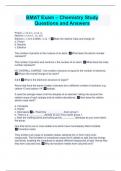
-
BMAT Exam – Chemistry Study Questions and Answers
- Exam (elaborations) • 8 pages • 2024
- Available in package deal
-
- £7.89
- + learn more
Proton = r.m is 1, r.c is +1 Neutron = r.m s 1, r.c. is 0 Electron = r.m is 0.0005, r.c is -1 State the relative mass and charge of: a. Proton b. Neutron c. Electron The number of protons in the nucleus of an atom. What does the atomic number represent? The number of protons and neutrons n the nucleus of an atom. What does the mass number represent? NO OVERALL CHARGE - the number of protons is equal to the number of electrons. What s the overall charge of an atom? 2,8,8 What is ...
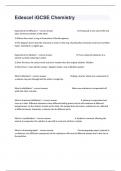
-
Edexcel iGCSE Chemistry Actual Exam With Well Elaborated Answers Graded A+.
- Exam (elaborations) • 42 pages • 2024
- Available in package deal
-
- £14.21
- + learn more
Experiment for Diffusion? - correct answer 1) HCl placed at one end of the test tube, ammonia solution at the other. 2) Where they meet, a ring of Ammonium Chloride appears. 3) The diagram shows that the ammonia is closer to the ring, showing that ammonia must have travelled faster, showing it's a lighter gas. Experiment for Dilution? - correct answer 1) Put a coloured substance in a solvent e.g f...
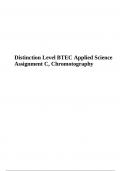
-
Distinction Level BTEC Applied Science Assignment C, Chromatography (Verified)
- Exam (elaborations) • 10 pages • 2024
-
- £9.87
- + learn more
Distinction Level BTEC Applied Science Assignment C, Chromatography (Verified) Chromatography : a method used to separate chemical mixtures for analysis Soluble :solubility is the degree to which a substance dissolves in a solvent to make a solution Solvent : the substance in which a solute dissolved to produce a homogeneous mixture Mobile phase : the liquid that transports the substance mixture through the absorbing material which travels along the stationary phase and carries the substance...
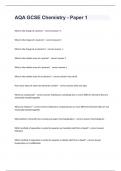
-
AQA GCSE Chemistry - Paper 1 Question Fully Solved Graded A+.
- Exam (elaborations) • 26 pages • 2024
- Available in package deal
-
- £11.05
- + learn more
What is the charge of a proton? - correct answer +1 What is the charge of a neutron? - correct answer 0 What is the charge of an electron? - correct answer -1 What is the relative mass of a proton? - correct answer 1 What is the relative mass of a neutron? - correct answer 1 What is the relative mass of an electron? - correct answer Very small How many types of atoms do elements contain? - correct answer Only one type What are compounds? - correct answer Substances containin...
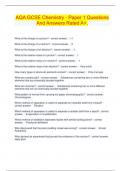
-
AQA GCSE Chemistry - Paper 1 Questions And Answers Rated A+.
- Exam (elaborations) • 20 pages • 2024
-
- £10.26
- + learn more
AQA GCSE Chemistry - Paper 1 Questions And Answers Rated A+. What is the charge of a proton? - correct answer. +1 What is the charge of a neutron? - correct answer. 0 What is the charge of an electron? - correct answer. -1 What is the relative mass of a proton? - correct answer. 1 What is the relative mass of a neutron? - correct answer. 1 What is the relative mass of an electron? - correct answer. Very small How many types of atoms do elements contai...
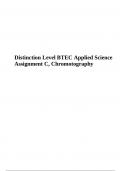
-
Distinction Level BTEC Applied Science Assignment C, Chromatography.
- Exam (elaborations) • 10 pages • 2024
-
- £10.26
- + learn more
Distinction Level BTEC Applied Science Assignment C, Chromatography. Mixture : a mixture is made when two or more substance are combined , but they are not chemically bonded together Chromatography : a method used to separate chemical mixtures for analysis Soluble :solubility is the degree to which a substance dissolves in a solvent to make a solution Solvent : the substance in which a solute dissolved to produce a homogeneous mixture Mobile phase : the liquid that transports the substance ...
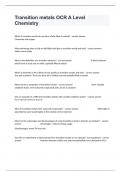
-
Transition metals OCR A Level Chemistry Comprehensive Exam With Questions & Correct 100% Verified Answers
- Exam (elaborations) • 5 pages • 2024
- Available in package deal
-
- £10.26
- + learn more
Which 2 transition metals do not have a fully filled 4s orbital? - correct answer Chromium and copper What advantage does a fully or half filled shell give a transition metal and why? - correct answer Makes more stable What is the definition of a transition element? - correct answer D-block element which form at least one ion with a partially filled d orbital Which 2 elements i...
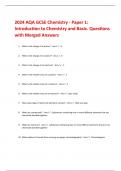
-
2024 AQA GCSE Chemistry - Paper 1: Introduction to Chemistry and Basic. Questions with Merged Answers
- Exam (elaborations) • 25 pages • 2024
- Available in package deal
-
- £9.08
- + learn more
1. What is the charge of a proton? - Ans .+1 2. What is the charge of a neutron? - Ans .0 3. What is the charge of an electron? - Ans .-1 4. What is the relative mass of a proton? - Ans .1 5. What is the relative mass of a neutron? - Ans .1 6. What is the relative mass of an electron? - Ans .Very small 7. How many types of atoms do elements contain? - Ans .Only one type 8. What are compounds? - Ans .Substances containing two or more different elements that are chemically bonded together...
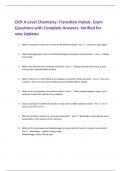
-
OCR A Level Chemistry: Transition metals. Exam Questions with Complete Answers. Verified for new Updates
- Exam (elaborations) • 5 pages • 2024
- Available in package deal
-
- £4.34
- + learn more
1. Which 2 transition metals do not have a fully filled 4s orbital? - Ans .Chromium and copper 2. What advantage does a fully or half filled shell give a transition metal and why? - Ans .Makes more stable 3. What is the definition of a transition element? - Ans .D-block element which form at least one ion with a partially filled d orbital 4. Which 2 elements in the d block do not qualify as transition metals and why? - Ans .Zinc and scandium. Their ions have full d orbitals and not part...
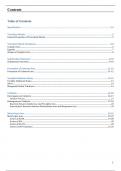
-
AQA A Level Chemistry - Unit 3.2.5-6 - Transition Metals and Metal-Aqua Ions - Full Notes
- Summary • 22 pages • 2023
- Available in package deal
-
- £5.29
- + learn more
Detailed and comprehensive notes on units 3.2.5 and unit 3.2.6 (transition metals and metal-aqua ions) for AQA A level chemistry. Covers: transition metal properties, transition metal complexes, substitution reactions, coloured ions, variable oxidation states, catalysts and metal-aqua ion theory (reactions, observations). Includes reactions and key facts to learn.

Did you know that on average a seller on Stuvia earns £76 per month selling revision notes? Hmm, hint, hint. Discover all about earning on Stuvia


